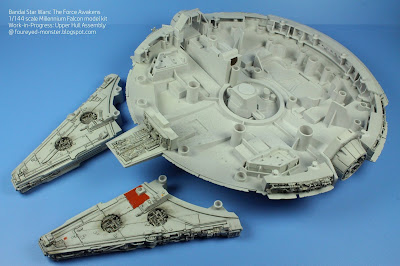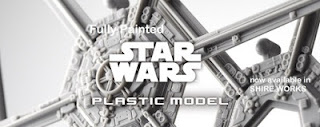With all its separate pieces and sub-assemblies fully painted and accounted for, the Millennium Falcon was finally ready to be put together. After years in this hobby, I seem to have settled upon a
modus operandi that involves painting a miniature figurine or scale model kit's parts first before assembling them. Most, if not all, of my projects have been carried out in this manner. Doing so has its pros and cons. The former being the ability to paint parts to a high degree of detail while the latter sometimes negated the former by causing damage to the paint during assembly. With that in mind, lets see how the final assembly process for the Millennium Falcon itself turned out.
 |
| 1/144 scale Millennium Falcon Work-in-Progress: Upper Hull snap-fitted onto the Lower Hull |
Steps can be taken to prevent paint chipping and decal damage when piecing together the separately painted pieces. Apart from the obvious step of being extra careful when handling the parts, one could also spray a protective clear topcoat onto the final layer of paint and decals. While all the care in the world isn't necessarily foolproof against damage to paint and decal, it can at the least minimizes it.
 |
| Forward Mandibles of the Millennium Falcon (closeup view) |
 |
| Forward Mandibles, prior to being attached to the inner edge of the Lower Hull |
 |
| Forward Mandibles, after they were attached to the inner edge of the Lower Hull |
 |
| Once the Upper Hull (not shown) is snap-fitted onto the Mandibles, the attachment becomes more secure |
Both Forward Mandibles are first attached via Lego-like connecting studs onto holes on the inner edge of the Lower Hull (
see above). At this stage the Mandibles weren't yet securely attached in that they could easily be shaken loose from the Lower Hull. A secure fit could only be achieved by fixing the Upper Hull onto Mandibles
and Lower Hull
also via similar Lego-like connecting studs and holes. This would then place the Mandibles firmly in between both hulls (
see final third of photos).
 |
| Underside of the Millennium Falcon Forward Mandibles, which attach to the Lower Hull |
 |
| Lower Hull (compared with Upper Hull) takes on a greater yellowish tint due to sand weathering effects |
My main concern about the Upper Laser Turret was whether it could blend inconspicuously into the Upper Hull. This worry arose because I did a less than stellar job on the Laser Turret's weathering effects. In the end, I guess everything turned out okay. Not great but okay. Unconsciously, I may just be trying to reassure myself that I didn't mess things up. Still, I intend to leave things well alone.
 |
| Upper Laser Turret prior to be fixed into the Millennium Falcon's Upper Hull |
 |
| Upper Laser Turret snap-fits securely onto the Millennium Falcon's Upper Hull |
 |
| Closeup view of the Upper Laser Turret once it has been attached to the Upper Hull |
And just like that the two halves were ready to be snap-fitted together. At this late point, you may have noticed that the Cockpit section still hadn't been attached to the Upper Hull. As per the instructions, both halves had to be fixed together first before the Cockpit section was inserted. I believe this method was suggested to prevent clumsy hands from somehow pressing too hard on the Cockpit and breaking it. Sans the cockpit, I actually had more surface area in which to apply force with my fingers in order to ensure both halves of the hull had indeed snap-fitted securely into place.
 |
| Bandai Star Wars 1/144 scale Millennium Falcon - Upper Hull and Lower Hull prior to being snap-fitted together |
Due to the flimsiness and fragility of certain sections of the Upper Hull, e.g. the Exposed Innards, Quad Laser Cannons and Radar Dish, I still had to be extremely careful not to accidentally press onto them and break them. But as mentioned in the preceding paragraph, there was enough unobstructed surface area for my fingers to rest on thus ensuring sufficient force was used to assemble both hulls.
 |
| Millennium Falcon's Upper Hull snap-fits so securely onto the Lower Hull ... |
 |
| ... that there is absolutely no need for any glue to be used in the assembly process |
At this stage, all that was left for me to do was insert the Cockpit into its rightful place. Similar to what has worked so well thus far, the Cockpit contained Lego-like connecting studs which allowed it to be fixed securely into the corresponding holes on the Upper Hull (
see below).
 |
| Similar to the other parts, the Cockpit section has Lego-like connecting studs ... |
 |
| ... which help it attach securely onto the Upper Hull via just a snap-fitting process |
 |
| Cockpit of the Millennium Falcon after it has been attached onto the ship's Upper Hull |
It's a great testament to Bandai's snap-fit design that absolutely no glue was needed during this final stage of assembly. If only the past me - more than four years ago - had realized this and had not glued shut the armor panel which allowed access to the on/off switch of an LED lighting system.
 |
| 1/144 scale Millennium Falcon completed and ready to be attached to its display stand/base |
Before I proceed to showcase the Millennium Falcon into its final form, there is the issue of its base to tackle. I expect this next step to be a quick one as I intend to put as little effort as I can get away with in order to make it work. There are reasons for putting minimal effort into the desert base which I'll make clear in the next post. For now it's time for - you guessed it - yet another quote to end my weekly (sometimes biweekly, sometimes semiweekly) blog posts. This one is from
William aka Man in Black from the HBO series
Westworld ...
"When you're suffering, that's when you're most real".































.jpg)


















